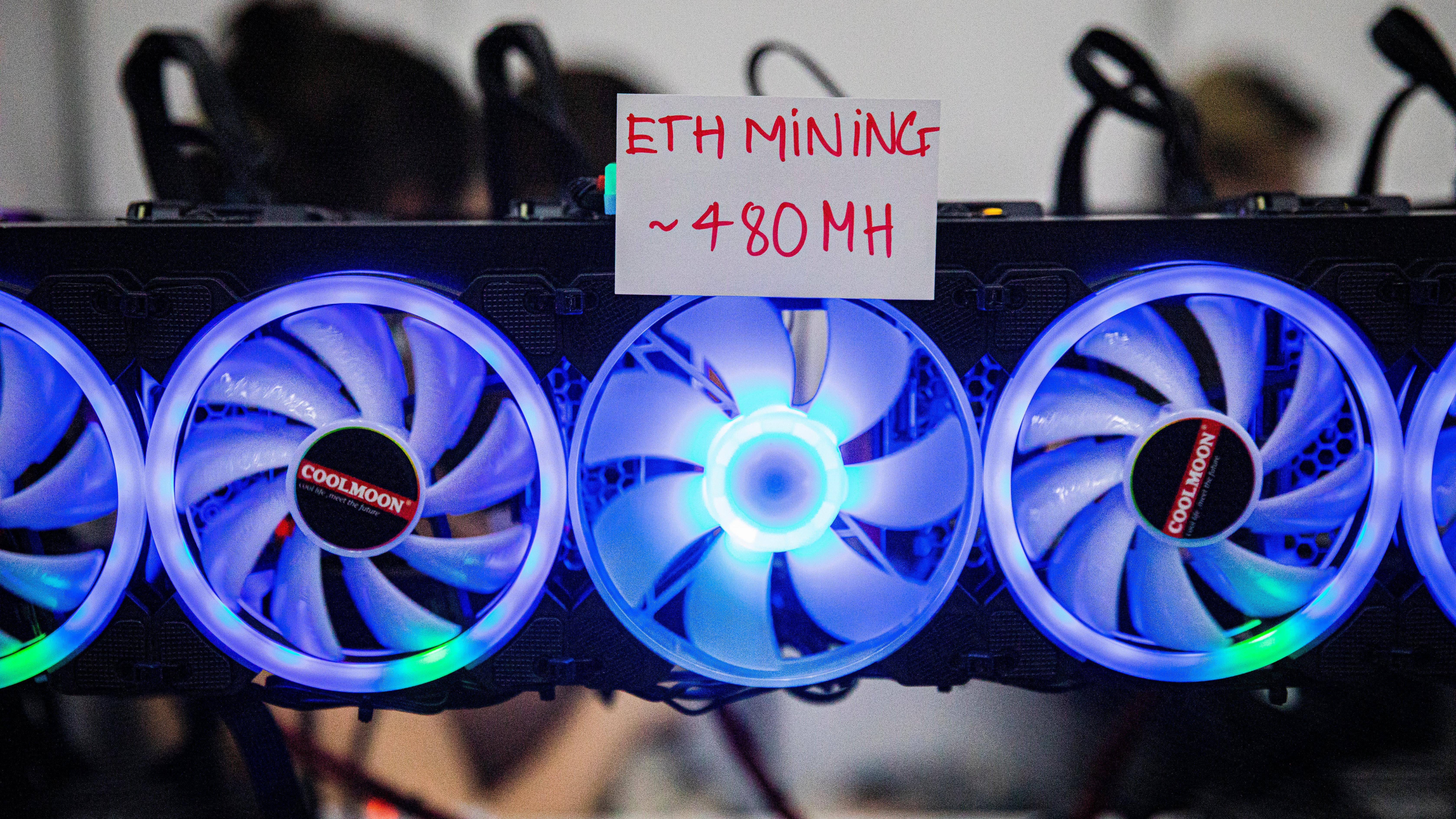There’s a date. That date is Sept. 19. That’s when those sitting like royalty at the top of the Ethereum blockchain say they’ll finally move their proof-of-work-based blockchain system over to proof-of-stake. They’ve made promises before and have routinely pushed back deadlines, but now they have a date, and so far, all those involved seem like they agree that’s when it can happen… maybe… hopefully.
Well, according to Ethereum developer Ben Edgington “it’s not do-or-die, it’s a coordination point to help everyone plan,” and the date could change by a few days. Still, all those involved in an Ethereum consensus devs call from last week agree Sept. 19 is the tentative “D-day,” so to speak.
So what the hell is all this anyway?
You’ve probably read about Ether’s planned move to proof of stake before, the news washing over you and dissipating, like the first drops of rain from an overcast sky. News of what’s been dubbed “The Merge” filtered into your feed, then out. You probably read that it would be happening “soon.” Then it gets pushed a few more months, and you go on with your life.
So to quickly sum it up, proof-of-work — which the biggest blockchains, bitcoin and ethereum, currently operate on — is a so-called “consensus mechanism” that essentially includes a whole lot of computers all trying to solve a cryptographic puzzle in order to add new info onto a database, earning a reward in return. It’s an extremely expensive process, where currently an estimated 130 terawatts per year is used to mine bitcoin, according to Digiconomist. At its height back in May, bitcoin required over 200 terawatts per year. That’s nearly the annual energy consumption of some small countries. At its height earlier this year, Ethereum was also using an approximated 100+ terawatts per year.
Proof-of-stake, by contrast, randomly chooses validators that will confirm that each transaction made on the blockchain is reliable, which then compensates each machine with crypto. Evangelists of POS say it will utilise 99% less energy, while the upgrade would speed up the network to reach between 15 and 100,000 transactions per second. The current system can only do a max of 30 per second, according to an explainer from Decrypt.
But despite all the promised benefits, it’s been a hard and long road. Proof-of-stake, if you couldn’t tell from the name, favours those that already have a certain amount of crypto staked in the system. In this case, being recognised as a validator requires a large enough initial investment on the part of “miners” to hold a minimum of the native Ethereum token, which could go up over time. This is why Ethereum’s transition requires so many validators to sign off and agree on a date. Node operators, those whose computers manage the chain, also need to be notified when to switch over, in order to make sure everything goes smoothly.
History of “The Merge”
The idea of proof of stake has been around for a decade. It even predates the very public identity of Ethereum. Founder Vitalik Buterin, a “butt-hurt warlock main on World of Warcraft,” first published his idea of a blockchain network that could power applications other than just money in late 2013. Ethereum would come into being in 2015, but Buterin was constantly pushing for proof-of-stake even when his own brainchild was entering the world without it.
According to CoinTelegraph, a 2012 paper by Sunny King and Scott Nadal wanted to prove there was a means to break away from bitcoin’s awful energy excesses. This would require systems to adopt a “staking” method, based on the number of crypto a user had, to be selected to add a block on a chain and reap the rewards. Of course, people feared this would lead to greater monopolization of the crypto scene. Though, even without a mass-adoption of proof-of-stake, we already have people like Sam Bankman-Fried, the CEO of FTX, using his vast fortune to buy up failing crypto exchanges. Monopolization is likely unavoidable either way, but proof-of-stake perhaps make it more explicit.

Despite recent anticipation for The Merge, Ethereum’s been talking about this for years. Buterin has long had POS in his sights, even writing about it back in 2013. Indeed, the founder wanted Ethereum to use this kind of system from the start, but he found the process too complicated. In 2015, the BitFury Group, a blockchain technology company, released another paper examining proof-of-stake. It called early POS algorithms “naïve,” since they would incentivise users on “forked” chains (or blockchains that are split in two) to double-spend, or otherwise allow attacks onto the chain. So in that way, POW systems remained, and the price of crypto — especially bitcoin and ether — rose to great heights over the coming years, barring massive slumps in both 2019 and now in 2022.
Bitcoin remains the largest and most profitable cryptocurrency out there, with some like Twitter founder Jack Dorsey calling it “the only candidate” for a native internet currency, while of course ignoring all the environmental drawbacks. Bitcoin is more decentralized than Ethereum (though much less so than you may think), but having more people at the top of the pile has allowed the blockchain some leeway in reinventing itself.
Still, as far back as 2016, Buterin and other Ethereum developer Vlad Zamfir had competing ideas for a POS transition. Back in 2017, CoinDesk reported that Ethereum developers were working on an alternative to POW known as “Gasper,” sometimes called “Casper.” Buterin described it as “consensus by bet.” This meant that those who were tapped into the system had the incentive for competing nodes to come to an agreement.
Though it took a relatively short time to get the actual Ethereum network from concept to execution, implementing proof-of-stake ultimately seemed to be a much harder task overall, despite developers’ public intentions. Despite constant promises of being “six months away,” it took years to finalise the algorithm and build a test net, and even longer to get the proper people on board. The first phase of the move, allowing staking on the Ethereum blockchain, went live at the end of 2020. This so-called Beacon Chain has already seen over 13 million ETH coins staked in it, worth about $US20 ($28) billion. They will have to merge that system with the main Ethereum chain during the implementation of Proof-of-Stake, hence the ominous “Merge” nickname.
Buterin told Fortune in 2021 “[We thought] it would take one year to [implement] POS… but it actually [has] taken around six years.”
Which takes us to 2022 and “The Merge.” Ethereum developers promised it for the first half of 2022, but the timing has remained vague. The team completed a test merge in May, simultaneously promising a June 8 release date. Of course, that came and went, and still no Merge.
So, Will it Actually Happen in September?
At this point, the stars seem to be aligning for a true-blue Merge. The sceptic in me wants to say that this is all just a carrot on a stick — with Ethereum devs pulling back the treat every time we get close — all just to keep this vague notion going that crypto won’t continue to be such a horrible drain on both electric grids and the environment.
However, just based on developers messages and blogs, there seems to finally be a true push from all the stakeholders involved toward the transition. It’s a task as complicated as transplanting the Empire State Building from Manhattan to the Moon. There are so many nodes, developers, stakeholders, and even regular holders who are all getting (in the latter case, an incredibly minor) say in the proceedings.
There is a large contingent of ether holders who are more than sceptical, thinking it could tank the value of ether, and at such a sensitive time for the crypto market. Ryan Berckmans, an Ethereum investor, said on the Unchained podcast that this move is a “long battle for the soul of Ethereum.” To go into all the back and forth here would take from now until when they finally figure out how to mint souls onto the blockchain (knowing Meta CEO Mark Zuckerberg, I’m giving it an honest half-decade). With the number of smart contracts and billions invested in coins on the Ethereum blockchain at stake, you can bet there’s going to be controversy.
As pointed out earlier this year in MIT Technology Review, you don’t have to look back too far to see how disagreement on Ethereum might go. When Ethereum was hacked in 2016, developers decided to fork the blockchain into Ethereum Classic and a new Ethereum, and some users — angry at being cut out — remained on the old chain. The chain would fork again multiple times, leaving some trading on the old versions and others on the new. It’s easy to see users jumping ship, using a new fork, or otherwise going back to older blockchains. All that would largely defeat the purpose of trying to make a cleaner, more reliable blockchain.
What Does “The Merge” Mean for Me?
Proof-of-work systems and their massive draw of electricity have had major impacts on local grid systems and on the environment as a whole. They are such a drain on electrical grids that countries like China and Iran have all but pushed them out completely. In Texas, grid officials have said that the energy draw of crypto mining would be more than that of all the residential homes in Houston by 2023.
Proof-of-work only adds to the ongoing e-waste problem. Some studies have estimated that the entire bitcoin mining network burns through 30.7 metric kilotons of equipment per year. These crypto mining operations have also sapped markets of GPUs, and the market has only gotten better now that the price of crypto has declined. When used in mining rigs, these cards often become obsolete in only 1.5 years, leading to increasing e-waste to add to an already frightening trend.
But we know all this. Crypto’s impact on the environment has been a common theme for years and years, and we’ve all been waiting years for Ethereum to get its act together and actually make this promised move.
So, will The Merge cure crypto? Well, it probably won’t make it worse. The intention is solid, despite what your thoughts are on crypto as a whole. But bitcoin still remains the biggest cryptocurrency. It currently has a $US440 ($611) billion market cap compared to ether’s $US188 ($261) billion. And after The Merge, we can expect that there will be people who don’t like the idea of an even more centralised blockchain, and will remain on the more dirty chains.
So if The Merge actually happens Sept. 19, there will be a period of chaos that will eventually settle. And even after that, we’ll still be dealing with the same issues we were before.
